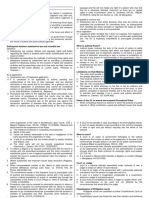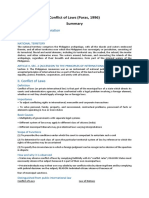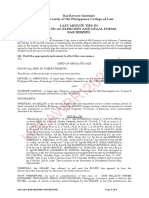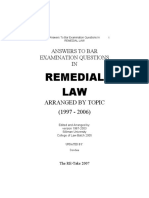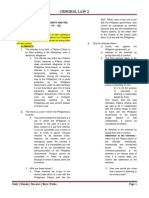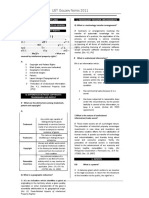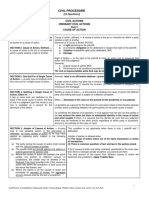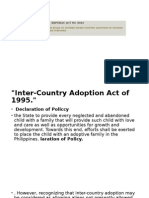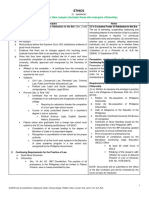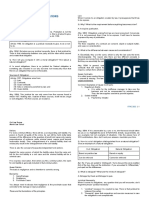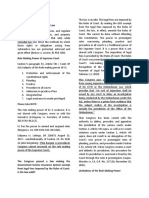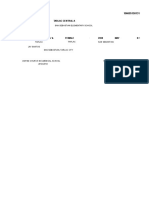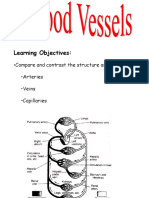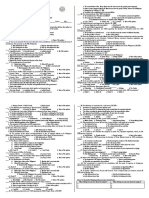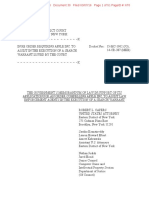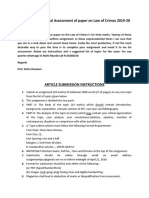REMEDIAL LAW REVIEWER
Emerald L. Lansangan & Ma. Theresa L. Reotutar Page
1
Remedial Law
Remedial Law is that branch of law which prescribes the method of enforcing rights or obtaining redress for their invasion.
Substantive Law vs. Remedial Law Judicial Power
It includes the duty of the courts of justice to settle actual controversies involving rights, which are legally demandable and enforceable, and to determine whether or not there has been grave abuse of discretion amounting to lack or excess of jurisdiction on the part of any branch or instrumentality of the Government
(Article VIII, Sec. 1, 1987 Constitution).
The judicial power shall be vested in one Supreme Court and in such other lower courts as may be established by law
(Art. VIII, Sec. 1, 1987 Constitution).
Rule-Making Power of the Supreme Court
Section 5 (5), Art. VIII of the Constitution provides that the Supreme Court shall have the power to: a. promulgate rules concerning the protection and enforcement of constitutional rights, pleading, practice, and procedure in all courts; b. admission to the practice of law; c. the Integrated Bar; d. and legal assistance to the underprivileged
Limitations of the Rule-making power of the Supreme Court
1) The rules shall provide a simplified and inexpensive procedure for the speedy disposition of cases 2) They shall be uniform for all courts of the same grade 3) They shall not diminish, increase, or modify substantive rights. 4) The power to admit attorneys to the Bar is not an arbitrary and despotic one but is the duty of the court to exercise and regulate it by a sound and judicial discretion.
Rules of procedure of special courts and quasi- judicial bodies shall remain effective unless disapproved by the Supreme Court.
Note:
In
ESTIPONA
v.
LOBRIGO (
G.R.No. 226679, August 15, 2017), Petitioner Salvador A. Estipona, Jr. (
Estipona
) is the accused for violation of Section 11, Article II of R.A. No. 9165 (
Possession of Dangerous Drugs
). Estipona filed a
Motion to Allow him to Enter into a Plea Bargaining Agreement
, it was however denied based on the provision of RA9165 that plea bargain is not allowed in violation of RA9165. The Supreme Court ruled that provision is unconstitutional because Sec 5(5) Art.VIII of the Constitution provides that the power to promulgate rules, practice, pleadings and procedure is now in the exclusive domain of the SC. In
MORALES
v.
COURT OF APPEALS (
G.R. Nos. 217126-27, November 10, 2015), Binay and other public officers and employees of the City Government of Makati were charged of plunder and violation of RA3019 before the Ombudsman. Ombudsman issued preventive suspension which Binay seeks to nullify. CA issued a TRO and/or WRI. Morales opposed contending that no writ of injunction shall be issued to delay the investigation being conducted by Ombudsman pursuant to Sec 14 RA 6770. The Court ruled that specific provision is unconstitutional. It held that the 1987 Constitution
took away the power of Congress to repeal, alter or supplement rules concerning pleading, practice and procedure.
Power of the Supreme Court to amend and suspend procedural rules Substantive Law Remedial Law
It is that part of the law which creates
,
defines
or
regulates
rights concerning life, liberty or property, which when violated gives rise to a cause of action. It refers to the rules prescribing methods whereby causes of action may be effectuated, wrongs redressed and reliefs obtained (also known as
Adjective Law
). It makes vested rights possible. No vested rights may attach to nor arise therefrom. It is prospective in application. It may be made applicable to actions pending and undetermined at the time of their passage and are deemed retroactive in that sense and to that extent. It originates from the legislature. It does not originate from the legislature but has the force and effect of law if not in conflict with substantive law. It cannot be enacted by the Supreme Court. The Supreme Court is expressly empowered to promulgate procedural rules.
G
ENERAL
P
RINCIPLES

REMEDIAL LAW REVIEWER
Emerald L. Lansangan & Ma. Theresa L. Reotutar Page
2
When compelling reasons so warrant or when the purpose of justice requires it = discretionary upon courts. Reasons that would warrant the suspension: 1) the existence of special or compelling circumstances; 2) merits of the case; 3) cause not entirely attributable to the fault or negligence of the party favored by the suspension of rules 4) a lack of showing that the review sought is merely frivolous and dilatory; 5) the other party will not be unjustly prejudiced thereby.
Where substantial and important issues await resolution.
When transcendental matters of life, liberty or state security are involved.
The constitutional power of the Supreme Court to promulgate rules of practice and procedure necessarily carries with it the power to overturn judicial precedents on points of remedial law through the amendment of the Rules of Court.
Note
: The rules may be relaxed so that the end of justice may be better served (Cruz v. CA 476 SCRA 581, 586). The Rules must not be applied rigidly so as not to override substantial justice
because rules of procedure must be used to facilitate, not frustrate substantial justice (Canton v. City of Cebu, 515 SCRA 441, 448).
Principle of Judicial Heirarchy
This is an ordained sequence of recourse to courts vested with concurrent jurisdiction, beginning from the lowest, on to the next highest and ultimately to the highest. This hierarchy is determinative of the venue of appeals, and is likewise determinative of the proper forum for petitions for extraordinary writs. This is an established policy necessary to avoid inordinate
demands upon the Court’s time and a
ttention which are better devoted to those matters within its exclusive jurisdiction, and to preclude the further clogging of the
Court’s docket
(Sec. 9[1], BP 129; Sec. 5[1], Art. VIII, Constitution of the Philippines)
.
A higher court will not entertain direct resort to it unless the redress cannot be obtained in the appropriate courts. The SC is a court of last resort. It cannot and should not be burdened with the task of deciding cases in the first instances. Its jurisdiction to issue extraordinary writs should be exercised only where absolutely necessary or where serious and important reasons exist. The doctrine of hierarchy of courts may be disregarded if warranted by the nature and importance of the issues raised in the interest of speedy justice and to avoid future litigations, or in cases of national interest and of serious implications. Under the principle of liberal interpretations, for example, it may take cognizance of a petition for certiorari directly filed before it.
Doctrine of Non-interference or Doctrine of Judicial Stability
Courts of equal and coordinate jurisdiction cannot interfere
with each other’s orders. Thus, the RTC has
no power to nullify or enjoin the enforcement of a writ of possession issued by another RTC. The principle also bars a court from reviewing or interfering with the judgment of a co-equal court over which it has no appellate jurisdiction or power of review. This doctrine applies with equal force to administrative bodies. When the law provides for an appeal from the decision of an administrative body to the SC or CA, it means that such body is co-equal with the RTC and logically beyond the control of the latter.
Jurisdiction
is the power and authority of the court to hear, try and decide a case.
Courts of Original and Appellate Jurisdiction
A court is one with original jurisdiction when actions or proceedings are originally filed with it. A court is one with appellate jurisdiction when it has the power of review over the decisions or orders of a lower court. MeTCs, MCTCs and MTCs are courts of original jurisdiction without appellate jurisdiction. RTC is likewise a court of original jurisdiction with respect to cases originally filed with it; and appellate court with respect to cases decided by MTCs within its territorial jurisdiction.
(Sec. 22, BP 129).
CA is primarily a court of appellate jurisdiction with competence to review judgments of the RTCs and specified quasi-judicial agencies
(Sec. 9[3], BP 129).
It is also a court of original jurisdiction with respect to cases filed before it involving issuance of writs of certiorari, mandamus, quo warranto, habeas corpus, and prohibition. CA is a court of original and exclusive jurisdiction over actions for annulment of judgments of RTCs
(Sec. 9 [1],[2], BP 129).
The SC is fundamentally a court of appellate jurisdiction but it may also be a court of original jurisdiction over cases affecting ambassadors, public ministers and consuls, and in cases involving petitions for certiorari, prohibition and mandamus
(Sec. 5[1], Art. VIII, Constitution).
The Supreme Court en banc is not an
J
URISDICTION
C
LASSIFICATION OF
J
URISDICTION
REMEDIAL LAW REVIEWER
Emerald L. Lansangan & Ma. Theresa L. Reotutar Page
3
appellate court to which decisions or resolutions of a division of the Supreme Court may be appealed.
Courts of General and Special Jurisdiction
Courts of general jurisdiction are those with competence to decide on their own jurisdiction and to take cognizance of all cases, civil and criminal, of a particular nature. Courts of special (limited) jurisdiction are those which have only a special jurisdiction for a particular purpose or are clothed with special powers for the performance of specified duties beyond which they have no authority of any kind. A court may also be considered general if it has the competence to exercise jurisdiction over cases not falling within the jurisdiction of any court, tribunal, person or body exercising judicial or quasi-judicial functions. It is in the context that the RTC is considered a court of general jurisdiction.
Courts of Exclusive and Concurrent Jurisdiction
Courts of exclusive
jurisdiction are those confined to a particular court to the exclusion of other courts. Courts of concurrent
jurisdiction are those that possessed by the court together with another or other courts over the same subject matter. The court obtaining jurisdiction first retains it to the exclusion of the others, but the choice of the court is lodged in those persons duly authorized to file the action (also referred to as confluent or coordinate jurisdiction).
Doctrine of Hierarchy of Courts
This is an ordained sequence of recourse to courts vested with concurrent jurisdiction, beginning from the lowest, on to the next highest and ultimately to the highest. This hierarchy is determinative of the venue of appeals, and is likewise determinative of the proper forum for petitions for extraordinary writs. This is an established policy necessary to avoid inordinate
demands upon the Court’s time and attention which are
better devoted to those matters within its exclusive jurisdiction, and to preclude the further clogging of the
Court’s docket (Sec. 9[1], BP 129; Sec. 5[1], Art. VIII,
Constitution of the Philippines) . A higher court will not entertain direct resort to it unless the redress cannot be obtained in the appropriate courts. The SC is a court of last resort. It cannot and should not be burdened with the task of deciding cases in the first instances. Its jurisdiction to issue extraordinary writs should be exercised only where absolutely necessary or where serious and important reasons exist. The doctrine of hierarchy of courts may be disregarded if warranted by the nature and
importance of the issues raised in the interest of speedy justice and to avoid future litigations, or in cases of national interest and of serious implications. Under the principle of liberal interpretations, for example, it may take cognizance of a petition for certiorari directly filed before it.
Doctrine of Adherence of Jurisdiction (Continuity of Jurisdiction)
Once a court has acquired jurisdiction, such jurisdiction cannot be ousted by subsequent events although they be of a character which would have prevented jurisdiction from attaching in the first instance. Once jurisdiction has been acquired, it continues until the court finally disposes of the case (Ramos v. Central Bank of the Philippines, G.R. No. L-29352, October 4, 1971).
General Rule
: A law enacted during the pendency of a case which transfers jurisdiction to another court does not affect cases prior to its enactment.
Exceptions
: 1. When the new law expressly provides for a retroactive application; 2. When the change of jurisdiction is curative in character. Regular courts engaged in the administration of justice are organized into four (4) levels: (a) First Level (MTCs, MeTCs, MCTCs)
–
which try and decide (1) Criminal actions involving: a. violations of city or municipal ordinances committed within their respective territorial jurisdiction; and b. offenses punishable with imprisonment not exceeding six (6) years irrespective of the amount of fine and regardless of other imposable accessory or other penalties, and (2) Civil actions including EJECTMENT CASES (FEUD) and recovery of personal property with a value of not more than P300,000 outside MM or does not exceed P400,000 in MM; (b) Second Level (RTCs, Family Courts) courts of general jurisdiction among the civil actions assigned to them by law are those in which the subject of litigation is: a. actions incapable of pecuniary estimation b. actions involving title to or possession of real property where the assessed value of the property exceeds P20,000 outside MM or exceeds P50,000 in MM. c. where the demand exclusive of interest, damages of
whatever kind, attorney’s fees, litigation expenses, and
cost, or the value of the personal property or
J
URISDICTION OF VARIOUS
P
HILIPPINE COURTS
REMEDIAL LAW REVIEWER
Emerald L. Lansangan & Ma. Theresa L. Reotutar Page
4
controversy exceeds P300,000 outside MM or exceeds P400,000 in MM. exercise appellate jurisdiction - Review cases appealed from courts of the first level. - (c) Third Level (Court of Appeals, Sandiganbayan) CA is an appellate court a. reviewing cases appealed to it from the RTC on questions of fact or mixed questions of fact and law b. decisions of the RTC in the exercise of original jurisdiction i. as a matter of right ii. as a matter of discretion. Occasionally, CA may act as a trial court, as in actions praying for the annulment of final and executory judgments of RTCs on the ground of extrinsic fraud subsequently discovered, against which no other remedies lies. Sandiganbayan has jurisdiction over all criminal and civil cases involving
•
graft and corrupt practices act
•
such other offenses committed by public officers and employees including those in GOCCs in relation to their office. It also has exclusive appellate jurisdiction over final judgments, resolutions, or orders of RTCs whether in the exercise of their own original or appellate jurisdiction over criminal and civil cases committed by public officers or employees including those in GOCCs in relation to their office. (d) Fourth Level (Supreme Court)
JURISDICTION OF THE SUPREME COURT
CRIMINAL CASES
EXCLUSIVE ORIGINAL JURISDICTION Petitions for certiorari, prohibition and mandamus against CA and Sandiganbayan CONCURRENT JURISDICTION a) With the CA and RTC: petitions for certiorari, prohibition and mandamus against the MTC b) With the CA: petitions for certiorari, prohibition and mandamus against the RTC c) with Sandiganbayan: petitions for mandamus, prohibition, certiorari, habeas corpus, injunction and ancillary writs in aid of its appellate jurisdiction and over petitions of similar nature, including quo warranto arising or that may arise in cases filed or which may be filed. APPELLATE JURISDICTION a) from the RTC in all criminal cases involving offenses for which the penalty is reclusion perpetua or life imprisonment, and those involving other offenses which, although not so punished, arose out of the same occurrence or which may have been committed by the accused on the same occasion; b) Automatic review where death penalty is imposed. c) By petition for review on Certiorari from the CA, Sandiganbayan and from the RTC where only error or question of law is involved
Note
: In
PP vs. Mateo
(2004), the SC held that while the Fundamental Law requires a mandatory review by the SC of cases where the penalty imposed is reclusion perpetua, life imprisonment or death, nowhere however, has it proscribed an intermediate review. If only to ensure utmost circumspection before the penalty of reclusion perpetua, life imprisonment or death is imposed, the Court now deems it wise and compelling to provide in these cases a review by the CA before the case is elevated to the SC. A prior determination by the CA on, particularly, the factual issues, would minimize the possibility of an error of judgment. If the CA should affirm the penalty of reclusion perpetua, life imprisonment or death, it could then render judgment imposing the corresponding penalty as the circumstances so warrant, refrain from entering judgment and elevate the entire records of the case to the SC for final disposition.
CIVIL CASES
EXCLUSIVE ORIGINAL JURISDICTION in petitions for certiorari, prohibition and mandamus against the CA, COMELEC, COA, CTA, Sandiganbayan CONCURRENT JURISDICTION 1) With Court of Appeals in petitions for certiorari, prohibition and mandamus against the RTC, CSC, Central Board of Assessment Appeals, NLRC, Quasi- judicial agencies, and writ of kalikasan, all subject to the doctrine of hierarchy of courts. 2) With the CA and RTC in petitions for certiorari, prohibition and mandamus against lower courts and bodies and in petitions for quo warranto, and writs of habeas corpus, all subject to the doctrine of hierarchy of courts. 3) With CA, RTC and Sandiganbayan for petitions for writs of amparo and habeas data 4) Concurrent original jurisdiction with the RTC in cases affecting ambassadors, public ministers and consuls. APPELLATE JURISDICTION 1) by way of petition for review on certiorari (appeal by certiorari under Rule 45) against CA, Sandiganbayan, RTC on pure questions of law and CTA in its decisions rendered en banc. 2) in cases involving the constitutionality or validity of a law or treaty, international or executive agreement, law, presidential

